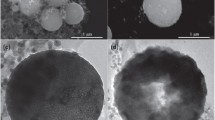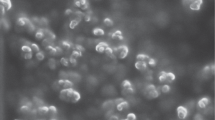Abstract
Ultrafine iron powder is widely used due to its excellent performance. Hydrogen reduction of fine-grained high-purity iron concentrate to prepare ultrafine iron powder has the advantages of low energy consumption, pollution-free, and low cost. The hydrogen reduction of high-purity iron concentrates, characterized by the maximum particle size of 6.43 μm when the cumulative distribution is 50% and the maximum particle size of 11.85 μm when the cumulative distribution is 90% while the total iron content of 72.10%, was performed. The hydrogen reduction could be completed at 425 °C, and the purity of ultrafine iron powders was more than 99 wt.% in the range of 425–650 °C. Subsequently, the effect of reduction temperature on various properties of ultrafine iron powder was investigated, including particle morphology, particle size, specific surface area, lattice parameters, bulk density, and reaction activity. It was found that the reaction activity of the iron powders prepared by hydrogen reduction was much higher than that of the products of carbonyl and liquid phase synthesis. Below 500 °C, the reduced iron powders were nearly unbound, with a small particle size and a low bulk density. The particles had a porous surface, with a specific surface area as high as 11.31 m2 g−1. The crystallization of reduced iron powders was imperfect at this time, the amorphization degree was prominent, and the interior contained a high mechanical storage energy, which had shown high reaction reactivity. It was suitable for catalysts, metal fuels, and other functionalized applications.













Similar content being viewed by others
References
T.B. Tengen, Analysis of characteristics of random microstructures of nanomaterials, University of the Witwatersrand, Johannesburg, South Afica, 2009.
T.B. Tengen, Int. J. Mech. Mater. Des. 8 (2012) 101–112.
J.R. Greer, J.T.M. De Hosson, Prog. Mater. Sci. 56 (2011) 654–724.
M. Gheju, I. Balcu, J. Hazard. Mater. 182 (2010) 484–493.
D. Sayed, A.A. Alturki, H. Farag, R.E. Khalifa, M.H. Abdel-Aziz, J. Ecol. Eng. 23 (2022) 273–280.
D. Kladeková, M. Heželová, L. Lux, Part. Sci. Technol. 25 (2007) 139–146.
D. Kladeková, M. Heželová, Chemical Papers 62 (2008) 553–558.
D.V. Lopes, M. Sillanpää, C. Wolkersdorfer, Mine Water Environ. 39 (2020) 280–290.
N.F. Song, Removal of nitrate from solution by chelating resin-supported Pd/Cu catalyst and zero valent iron, Chongqing University, Chongqing, China, 2022.
S. Zhao, Treatment of wastewater containing low content of nitrate by reduced iron powder, South China University of Technology, Guangzhou, China, 2019.
J.Y. Zhu, L.S. Zhang, J.Y. Liu, S. Zhong, P. Gao, J.Y. Shen, Water Res. 226 (2022) 119186
P. Pranda, V. Hlavacek, M.L. Markowski, Ind. Eng. Chem. Res. 40 (2001) 3331–3336.
J.H. Kim, H.Y. Koo, S.K. Hong, J.M. Han, H.C. Jang, Y.N. Ko, Y.J. Hong, Y.C. Kang, S.H. Kang, S.B. Cho, Adv. Powder Technol. 23 (2012) 387–392.
B. Czajka, Z. Foltynowicz, L. Wachowski, Cent. Eur. J. Energ. Mater. 11 (2014) 271–283.
K.S. Sista, S. Dwarapudi, D. Kumar, G.R. Sinha, A.P. Moon, J. Alloy. Compd. 853 (2021) 157251.
S.G. Belyavskii, P.G. Mingalyov, F. Giulieri, R. Combarrieau, G.V. Lisichkin, Prot. Met. 42 (2006) 244–252.
H.B. Liu, H.Y. Lu, China Metal Bulletin (2017) No. 6, 98–99.
X. Deng, J.J. Liu, Materials Science and Engineering of Powder Metallurgy 17 (2012) 345–349.
W.L. Peng, Y. Bai, Q.H. Liu, W.B. Zhao, Y. **n, C.Q. Huang, H.X. Shi, Chinese Journal of Vacuum Science and Technology 39 (2019) 537–541.
Y.H. Zhang, C. Li, Z.M. Yuan, Y. Qi, S.H. Guo, D.L. Zhao, J. Iron Steel Res. Int. 29 (2022) 537–551.
D.Y. E, L.Y. Wen, G.W. Tang, J. Li, G.C. Wei, J.X. Cui, J. Iron Steel Res. Int. 30 (2023) 2173–2185.
R. Tahmasebi, M. Shamanian, M.H. Abbasi, M. Panjepour, J. Alloy. Compd. 472 (2009) 334–342.
P. Pourghahramani, E. Forssberg, Int. J. Miner. Process. 79 (2006) 106–119.
J.T. Wu, B. Xu, Y.J. Zhou, Z.L. Dong, S.G. Zhong, T. Jiang, Sep. Purif. Technol. 307 (2023) 122784.
S.K. Kuila, R. Chatterjee, D. Ghosh, Int. J. Hydrogon Energy 41 (2016) 9256–9266.
C.J.M. Hessels, T.A.M. Homan, N.G. Deen, Y. Tang, Powder Technol. 407 (2022) 117540.
K. Nassau, Color Res. Appl. 12 (1987) 4–26.
Acknowledgements
We gratefully thank the financial support of the National Natural Science Foundation of China (52174330).
Author information
Authors and Affiliations
Corresponding author
Ethics declarations
Conflict of interest
Zhi-yun Ji is a youth editorial board member for the Journal of Iton and Steel Research International and was not involved in the editorial review or the decision to publish this article. The authors declare that they have no known competing financial interests or personal relationships that could have appeared to influence the work reported in this paper.
Rights and permissions
Springer Nature or its licensor (e.g. a society or other partner) holds exclusive rights to this article under a publishing agreement with the author(s) or other rightsholder(s); author self-archiving of the accepted manuscript version of this article is solely governed by the terms of such publishing agreement and applicable law.
About this article
Cite this article
Gan, M., Guo, Ed., Li, Hr. et al. Production of ultrafine iron powder by low-temperature hydrogen reduction: properties change with temperature. J. Iron Steel Res. Int. (2024). https://doi.org/10.1007/s42243-024-01228-z
Received:
Revised:
Accepted:
Published:
DOI: https://doi.org/10.1007/s42243-024-01228-z




